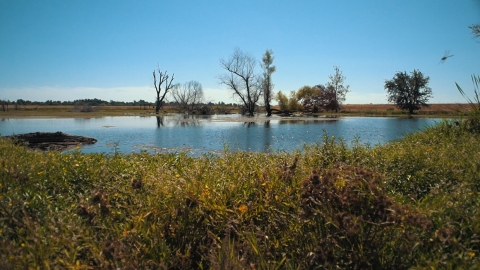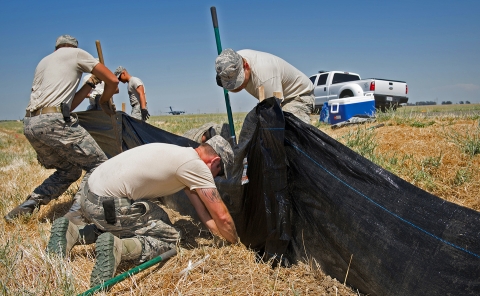Our Services
Section 7 Section 7
Section 7 Consultation
The Endangered Species Act (ESA) directs all Federal agencies to work to conserve endangered and threatened species and to use their authorities to further the purposes of the Act. Section 7 of the Act, called "Interagency Cooperation," is the mechanism by which Federal agencies ensure the actions they take, including those they fund or authorize, do not jeopardize the existence of any listed species.
Learn more about Section 7 Consultations
The Sacramento Fish and Wildlife Office works with Federal agencies under Section 7 of the Endangered Species Act. Federal agencies are required to consult with the Service under Section 7 when federal projects may result in take of a listed species or damage critical habitat for a listed species. Each year, the Sacramento Fish and Wildlife Office completes hundreds of formal and informal consultations with other federal government agencies, keeping project timelines on-track and wildlife and habitat protected.
Resources:
- Section 7 consultations completed by the Sacramento FWO can be found on ECOS.
- Learn more about Section 7 consultations.
- The Information, Planning, and Conservation System (IPaC) is an online conservation tool that helps people explore landscapes and minimize project-related conflicts with natural resources. With IPaC IPaC
Information for Planning and Consultation (IPaC) is a project planning tool that streamlines the USFWS environmental review process
Learn more about IPaC , you can generate species lists, view critical habitat and land cover, and other resource map layers. - Santa Rosa Plain Conservation Strategy
Habitat Conservation Plans
Conservation of wildlife and open spaces does not have to conflict with economic growth and development. Habitat conservation plans (HCPs) provide a path to balance wildlife conservation with development. The primary objective of the HCP program is to conserve species and the ecosystems they depend on while streamlining permitting for economic development.
The Sacramento Fish and Wildlife Office approved the Service’s first HCP in 1982 (San Bruno Mountain HCP). Since then, the office has reviewed, assessed and permitted hundreds of HCPs throughout the office’s jurisdiction.
We review HCPs developed by a wide range of landowners and partners, from renewable energy and timber companies to community developers and county planners. Some of the plans are large; encompassing entire counties or multiple counties. Others cover specific projects just a few hundred acres in size. Our review helps ensure that mitigation measures are included in the plan to minimize impacts to listed species and results in conservation for the species in the area. Our review and approval of the project results in issuing a permit for the project to the landowner. The public has an opportunity to comment on projects before they are permitted. Whether large or small, HCPs help conserve habitat for threatened and endangered species and aid in species recovery and persistence into the future.
Resources:
- HCPs permitted by the Sacramento Fish and Wildlife Office can be found by searching our Library
- Learn more about HCPs.
Working with the Military
The U.S. Fish and Wildlife Service works in coordination with military installations to manage natural resources on military lands under the Sikes Act. All military installations with significant natural resources are required to develop and implement integrated natural resources management plans (INRMPs) in cooperation with the U.S. Fish and Wildlife Service and the appropriate state wildlife agency.
The Sacramento Fish and Wildlife Office works with several military installations in California, including Beale Air Force Base and Travis Air Force Base. As partners, we work together to maximize on-site conservation efforts and provide guidance related to habitat management and species protection. Projects on military bases range from dismantling dams that have lost their purpose to guiding the development of new infrastructure to building pollinator gardens. Military bases have been great conservation partners, implementing projects that support the recovery of listed and at-risk species.
Resources:
Waterway Planning Work
The Sacramento Fish and Wildlife Office assists the Army Corps of Engineers and California Department of Water Resources in the planning, design and implementation of water resource projects and their operation and maintenance under the Fish and Wildlife Coordination Act. Projects include flood damage reduction and riverine restoration. The Sacramento Fish and Wildlife Office assists flood agencies under section 7 and section 10 of the Endangered Species Act on flood damage reduction projects. The Sacramento Fish and Wildlife Office also assists these agencies with species surveys, migratory bird nesting surveys and compliance monitoring.
Resources:
Conservation Banks
Conservation banks are large pieces of land that are permanently protected and managed for endangered, threatened, or at-risk species. Conservation banks function to offset adverse impacts to listed and at-risk species that occurred elsewhere. This is better known as off-site mitigation.
The Sacramento Fish and Wildlife Office has approved 87 conservation banks in California totaling 48,608 acres of land conserved for species mitigation. We work closely with conservation bank owners to ensure the habitat is permanently conserved and managed. When a conservation bank is approved, the Service authorizes a specified number of habitat or species “credits” that bank owners may sell to developers or other project proponents to mitigate for the impacts resulting from their projects. Bank owners contribute a portion of the sale to an endowment that provides money for the management and protection of the bank property in perpetuity. The office is in the process of approving dozens of additional banks.
Resources:
- Information on each conservation bank in our jurisdiction can be found in the "Conservation Bank Guide: Sacramento Fish and Wildlife Office" which can be downloaded from our Library.
- Learn more about conservation banking.







